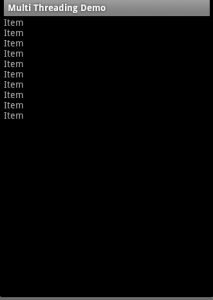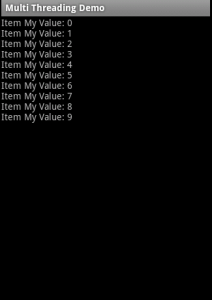Android App Development:Threading part 1: Handlers
Multi-Threading concept is essential in most platforms. it provides maximum utilization of the processor. threading is used when the program executes time consuming processes (such as calling a web service) and to give a good user experience by unblocking the UI.
Android provides threading techniques to perform time consuming tasks in a background thread with coordination with the UI thread to update the UI.
Android provides the following methods of threading:
- Handlers.
- Async. Tasks.
Handlers:
When you create an object from the Handler class, it processes
Messages and Runnable objects associated with the current thread MessageQueue. the message queue holds the tasks to be executed in FIFO (First In First Out) mannser. you will need only ine Handler per activity where the background thread will communicate with to update the UI.
The Handler is associated with the thread from which it’s been created
We can communicate with the Handler by two methods:
- Messages.
- Runnable objects.
In this post we will demonstrate how to use both using a simple example which is updating the text of a TextView using multiple threads.
Using Messages:
The steps of using a Handler are as follows:
- You create a Handler object with an asscociated callbackmethod to handle the received messages (it is the method where the UI updatewill be done).
- From the background thread you will need to send messages to thehandler.
Here’s the code of our activity:
public class MainActivity extends Activity {
TextView txt;
// our handler
Handler handler = new Handler() {
@Override
public void handleMessage(Message msg) {
//display each item in a single line
txt.setText(txt.getText()+"Item "+System.getProperty("line.separator"));
}
};
/** Called when the activity is first created. */
@Override
public void onCreate(Bundle savedInstanceState) {
super.onCreate(savedInstanceState);
setContentView(R.layout.main);
txt=(TextView)findViewById(R.id.txt);
}
@Override
protected void onStart() {
super.onStart();
// create a new thread
Thread background=new Thread(new Runnable() {
@Override
public void run() {
for(int i=0;i<10;i++)
{
try {
Thread.sleep(1000); b.putString("My Key", "My Value:
"+String.valueOf(i));
// send message to the handler with the current message handler
handler.sendMessage(handler.obtainMessage());
} catch (Exception e) {
Log.v("Error", e.toString());
}
}
}
});
background.start();
}
}
After running the following code the TextView will display the following,
Each second a new line is written:

This example is pretty basic, it just sends the same message for a number of times.
What if we want the message sent to hold data that’s changed each time the message is sent, the answer is to use Message.setData(Bundle bundle) method by creating a Bundle object and adding the data to it like this:
public class MainActivity extends Activity {
TextView txt;
// our handler
Handler handler = new Handler() {
@Override
public void handleMessage(Message msg) {
// get the bundle and extract data by key
Bundle b = msg.getData();
String key = b.getString("My Key");
txt.setText(txt.getText() + "Item " + key
+System.getProperty("line.separator"));
}
};
/** Called when the activity is first created. */
@Override
public void onCreate(Bundle savedInstanceState) {
super.onCreate(savedInstanceState);
setContentView(R.layout.main);
txt = (TextView) findViewById(R.id.txt);
}
@Override
protected void onStart() {
super.onStart();
// create a new thread
Thread background = new Thread(new Runnable() {
@Override
public void run() {
for (int i = 0; i < 10; i++) {
try {
Thread.sleep(1000);
Message msg = new Message();
Bundle b = new Bundle();
b.putString("My Key", "My Value: " + String.valueOf(i));
msg.setData(b);
// send message to the handler with the current message handler
handler.sendMessage(msg);
} catch (Exception e) {
Log.v("Error", e.toString());
}
}
}
});
background.start();
}
}
We put a string to the bundle and send a message with that bundle. in the handler method we receive the bundle and get the value with the predefined key.
After executing that code the text view would look like this:

Using Runnables:
another way to use Handlers is to pass them a Runnable by using the
Handler.post() method like this:
Runnable r=new Runnable() {
@Override
public void run() {
txt.setText("Runnable");
}
};
handler.post(r);
This will add the Runanble object to the message queue to be executed by the handler.
Sending Messages in a timely manner:
we can use handlers to send messages or post runnables at time intervals using
The following methods:
- handler.sendEmptyMessageAtTime(int what,long uptimeMillis):sends an
empty message at a specific time in milli-seconds, can be defined by using the
SystemClock.uptimeMillis() method to get the time since the device boot
in milli-seconds and concatinating to it. - handler.sendEmptyMessageDelayed(int what,long delayMillis):sends an
empty message after a certain amount of time in milli-seconds. - handler.sendMessageAtTime(Message msg,long uptimeMillis).
- handler.sendMessageDelayed(Message msg,long delayMillis).
- handler.postAtTime(Runnable r,long uptimeMillis).
- handler.postAtTime(Runnable r,Object token,long uptimeMillis):posts a
runnable with an object as a distinguishing token. - handler.postDelayed(Runnable r,long delayMillis).
All the above messages return a boolean indicating whether the message or the runnable has been placed successfully in the message queue.
Removing Call backs:
If you want to remove a runnable or a message from the message queue, you can use the following methods:
- handler.removeCallbacks(Runnable r).
- handler.removeCallbacks(Runnable r,Object token).
- handler.removeCallbacksAndMessages(Object token).
- handler.removeMessages(int what).
- handler.removeMessages(int what,Object object)
That’s was all about handlers, stay tuned for another tutorial next week.





 android
android 